How to Make a Table: Project Info
Posted 9 August 2016
This is the introduction for a free series. Want to watch the whole thing? It is free to do so, you just need to log into the site, and you can enjoy this series and many other videos we think you will love.
Description
In this project, Paul goes through the steps it takes to make a table. He starts with the material stock and follows through to the completion of a small table. These techniques and methods can be applied to the construction of any number of styles and sizes of table, from an end table to a dining table.
The tools you will need are:
- Knife
- Square
- Combination gauge (or marking gauge and mortise gauge)
- Tape/Ruler (or both)
- *Calipers
- Chisel hammer
- Chisels (at least 3/8″ and 1″)
- *Hand router (see how to make a ‘Poor Man’s Router here)
- Smoothing plane (No 4)
- Spokeshave
- Mortice guide
- Handsaw
- Tenon saw
- Dovetail saw
- *No 80 Cabinet Scraper
- *Card scraper
- Hand drill or drill driver
- Square Awl
* = optional
Joints List:
- Mortise & Tenon

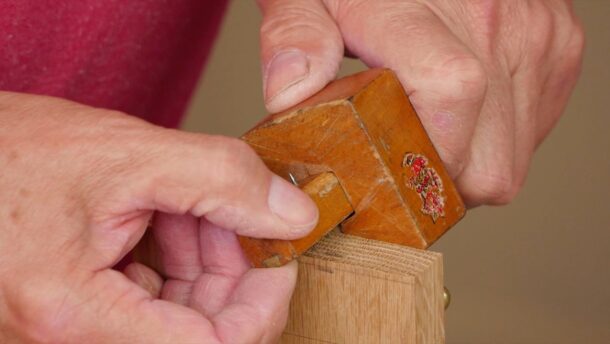
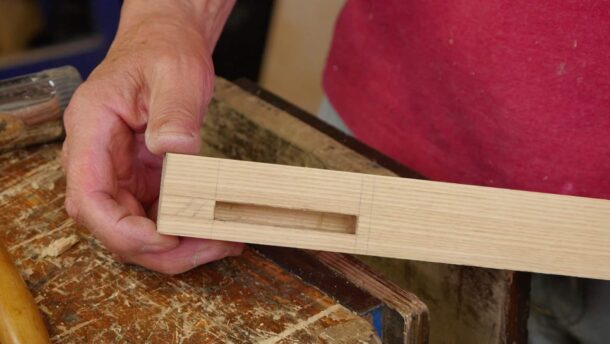
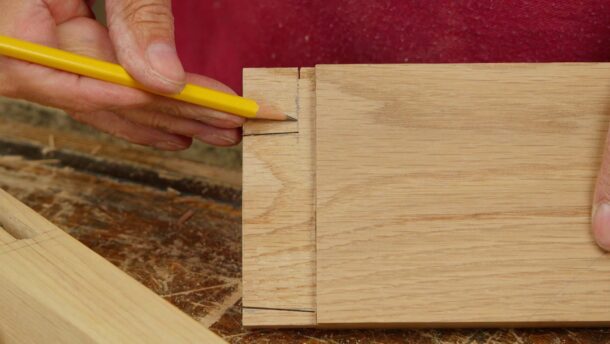
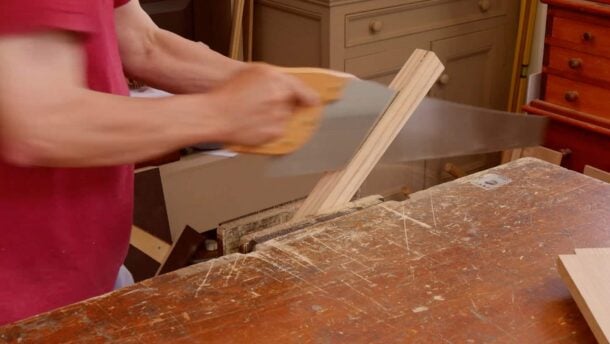
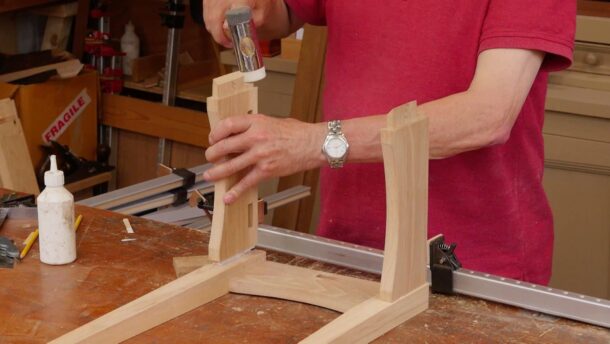
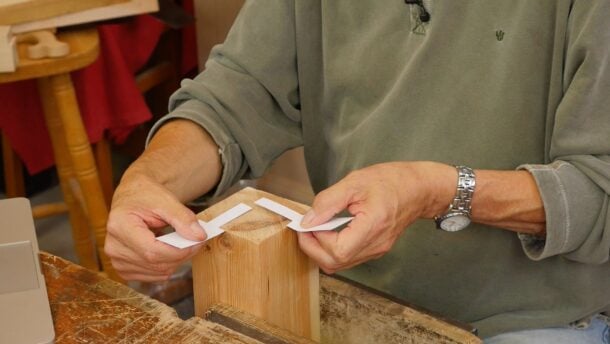
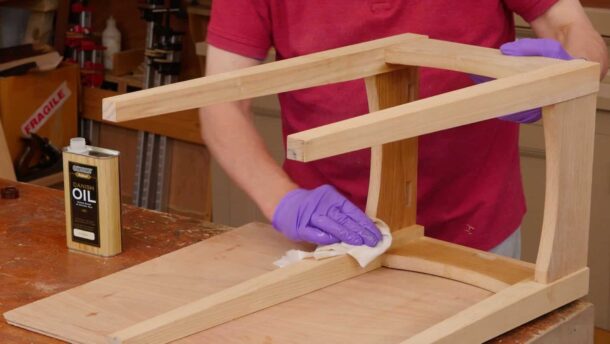
Why another table? Is there something to be learned by this table that wasn’t already covered by the “Occasional Table” project or the “Sofa Table project”?
I was thinking that myself…looks an awful lot like the occasional table doesn’t it.
Yes i have to agree with you guys. do we really need another table project?
I was under the impression this video was about the *why* and not the *how* – something I feel has been skipped over in other projects. If I am right, then I don’t mind if it is another table build.
This the first basictable walk through. 2 of the others are pretty elaborate first time pieces, and the occassional table was historical recreation, more about the reproduction of a half breadboard top table, than the basic design of a table.
This is more a starter table video than others, so a good fit for Paul’s goals.
I need another table project as this is the first one I have seen. I’m pretty sure that Paul does not insist that you watch his videos, so why don’t you just skip this series and go and do something else?
Absolutely spot on comment. I love the videos and always learn something, especially when I think I know about it already.
As you say, if you think you know it all find something else to do, or post a video of your teaching work.
Thanks Paul, keep up the good work.
As someone who is just starting out, I can say that I am looking forward to this project. I can see that it will be very useful for learning the basics of table building.
I watch all his videos even if they seem redundant. There is always something new to pick up.
We don’t know the exact details of the construction yet, but I’m inclined to be disappointed with what appears to be another conventional occasional table.
If we need to pursue making tables, Paul, how about exploring a pedestal type with sliding dovetails? Complicated, I know but a lot of us would welcome the challenge.
Just a thought.
Paul, I enjoy all your projects. I often view previous episodes and find something I missed the first time. Even though this is another table, I’m confident there will be much to learn. To me it’s about the learning process to develop my skills to do real woodworking.
Thanks,
Ray Ziegler – Birmingham, USA
Very much agree with Ray!
I agree 100%. To me, the end product is irrelevant. I watch Paul’s videos because I’m learning his woodworking techniques. Proper technique is SO important. And the best way to learn is by watching someone who has honed their skills over half of a century. As they say, “it’s good to learn from your own mistakes, but it’s even better to learn from others'”, as you save much time and frustration when you learn from others’ mistakes.
Cheers.
I am looking forward to this project, I actually have a need for a couple small tables so this could be another fun project.
Steve
Based on the comments, looks like we have a tough crowd. That said, I would like to see the addition of a drawer. I’ve read a lot about the drawer aprons inside tables, so am curious about the best style.
I’d also love to see the making of a drawer for this table.
Please add a drawer to this table.
I’ve already made a half dozen of these from your book.
If I am not mistaken, the project after this will be the rocking chair which ought to be quite a bit more challenging.
Drawers would be nice, yes.
This project is one of the projects from the foundational course, so while it may not be completely new in terms of technique, it is a good complement of the projects archive here at woodworkingmasterclasses. And as has been said, there’s always something to learn from watching Paul work and from the countless side notes.
David
How did you hear about the next project? Did I miss the announcement of the rocking chair?
I saw something about saw horses on the blog?
Apparently, it’s currently being filmed (https://www.instagram.com/p/BIqJuXGBnhS/?taken-by=paul.a.j.sellers) and to be out in “a few weeks” (https://paulsellers.com/2016/07/unasked-question-need-become-woodworker/).
I would love to see the addition of a drawer as well.
Wayne
Evening all.
There’s an old saying that goes;
From the little acorn the mighty oak tree grows.
Though some may find this table project repetitious , mastering the basics leads to competence in the more complicated stuff which ,if i’m not mistaken is what masterclasses is all about.
If anyone feels this project to be a little simple and are at a stage where their skills are above this then surely with a little imagination coupled the goldmine of information and tuition given in all and even the simplest of Paul’s videos it wouldn’t be too big a leap to design and build something a bit more complicated themselves.
i suppose that’s the difference between imitators and innovators.
I’m sure there’s plenty to be gleaned from this one as there is with all the others.
Notwithstanding its a pleasure to watch a master craftsman at work whatever he’s at.
Well said. I would only add that skill comes with actual practice. Watching these tutorials is tremendously useful to learning the techniques of the craft and seeing them performed skillfully. The more the better. But my skill, though never so masterful, will be developed at the bench.
Well said.
I am a teacher my self, not of woodworking, and with time and experience I learned that in order to teach my students further advance tecniques it is necessary to go back to the basics. I do practice myself the basics and I always discover something new that can be added and so the basics will be always better to make the advanced easier, safer and deeper. I do actually like this video very much and watching it I learned something new that could have saved me on previous projects. The teaching is clear, as usual of course, but being a bit dum I like the clear step by step explanation. The other day I started a new wall clock and my skills and control have improved so much.
Thank you Paul and team.
Antonio.
Daragh Holmes
Thank you! Your are spot on with your comment. I could not agree more.
Dan
After all Paul has taught us I don’t know how those that crump, can make thoughtless comments as above……….nowhere but nowhere on the internet is there such a feast of knowledge given for such a modest monthly outlay plus more for free.
I’ll stop at that…….John 2V
I don’t see how my comments were thoughtless. Mr. Sellers has been an inspiration to me or I wouldn’t be here. The fact is that this is a rehash of what has already been shown. I can watch his videos over and over and learn something each time, but everybody has access to the previous videos (even new members) and can watch those over and over. It was a simple question of what is new in this project, not an insult!
Well, I don’t comment very often but I feel I must throw in an observation. I have felt that some of the past projects looked repetitive up front. But I have always found that there was some additional content that was not presented before or presented in quite the same fashion. So I would kindly suggest that we wait and see what the class is all about before passing judgement.
I have yet the doubt Paul or the woodworking master classes team, there will no doubt be huge value to this project as with all the others. I very much look forward to it.
Hello All,
Thank you for all your interactive comments and recommendations. All very helpful. We always consider different points of view and differing circumstances when planning and filming new projects.
When we took the decision to put this out as a project, it was due to Paul wanting to present a scalable, versatile table using his recommended techniques and without any excess details or complications. It is particularly suited for new woodworkers as well as adaption, and we felt it important to have a project like this in the Woodworking Masterclasses archive. A similar table has long been part of Paul’s training program.
It may well repeat some of the methods and techniques from other projects, as well as including project specific details, but it is important for the project to contain all the steps required to make this project. The repetition of methods is key for the development, reinforcement and establishment of skill. In this case it give Paul the opportunity to talk about the broader applications of those particular skills.
I hope that helps answer some questions. If you have further comments or questions, please feel free to discuss them in the forums or email us through the contact tab.
Best,
Phil and the Woodworking Masterclasses Team
Thank you, Phillip. Well stated.
Hi Philip
I was going to add a post to this table but I wanted to add some photos which I am unable to do as there is no add file ability so I thought I would go to the Master classes project list but this table does not appear to be on the list
Best Regards
David
Hello David (@daveg), if you wish to add a picture to the gallery, you can submit it to the Gallery under Other, and Mark will mark a new gallery category for it. Otherwise, you can post in the forums and there is a way of attaching pictures there.
Best, Phil
Hi Phil
I would want to add the post under forums Project Series Table Project
But unless I am missing it I can not see the table project in the Project series list
Best Regards
David
Great point David (@daveg). Mark has just added the page:
https://woodworkingmasterclasses.com/discussions/forums/project-series-discussions/how-to-make-a-table/
I personally am looking forward to the videos and making a couple of these simple tables. Teach on!
I really welcome the new table project. I plan to follow along as I would like a nice side table and continue building my skills. Looks great!
On an even more basic level I would really like to see a tutorial video on dimensioning stock for a project and getting all the pieces to be of equal size using hand tools prior to joinery. This procedure is certainly a task that continuous to be the most challenging for me personally. Boring perhaps, but I feel it would prove to be an enormous benefit to me and possibly to others.
Howard
Have a look at the techniques videos .there’s some good ones there about stock prep , Jointing and planing, definitely worth watching
https://woodworkingmasterclasses.com/tool-technique-videos/
Regards
Glenn
Plus 100
Paul,
I agree with the other people commenting on the table forum. However, while these techniques are covered in previous videos, it is very helpful to watch another series on them. I appreciate how you show each step of the process (and sometimes even with each of the four parts – for example scribing each of the four legs with the gauge), because it offers a longer window into your thoughts as you work.
What would make this project worth the paid subscription (even with the occasional table series) is either/both:
1) incorporation of a drawer (if even talking through it and providing a PDF adaptation)
2) talking through (and providing a PDF adaptation of) the sizing and dimensioning for the various sized tables you referenced in your intro video (0:35-0:45).
Please Consider,
Joshua
I have respect to everyone and what they say but what does it mean “What would make this project worth the paid subscription ” When you go to a classical music concert to listen a master are you shouting from your seat when you didn’t like what he or she is playing? I think no. You are just enjoying. Everybody is free to share what they are thinking about topics and it creates productive interaction but who is talking about money can you please stop because it is hurtful.
Would you sell your 1 minute after 50 years experience on something for 15 USD? He is sharing the biggest online literature with us and he is giving a chance people to improve some skill and even to create their own business. Everything just for 15 USD? People working to prepare all this videos so on. We are not in the market to complain about tomatoes what we are buying. We are in his land and to understand his wisdom and creativity.
He is 66 years old and still he is working every day min 8 hours to share all these wonderful knowledge with us. I invite you to be more respectful and not to compare his wisdom with money.
I totally agree Will
Another table project is hardly the end of the world. There is always useful information in all of the projects here whether you build them or not. The only thing I would really like to see added in this respect is making a table with a circular or oval top, which I don’t recall seeing in any of the Masterclasses before. Otherwise, I look forward to giving it a try.
I don’t get the negative comments on here. I came on this site to learn hand tools. The best way I have found to do that is by doing something more then once. Watch these upcoming videos and I bet you come away with more knowledge on how to do something. It’s the journey folks. Enjoy.
i think what people should remember here is we’re paying a meagre amount for watching and learning from a master craftsman who is devoted to preserving and passing on skills that are, sadly for the most part practiced by hobbyists. a number of whom it would seem presume to know more than a man with fifty years experience.
the Making and fitting of a drawer while requiring skill to execute aint rocket science to figgure out.
have a look at any traditional drawer set up and if you cant join the dots then keep watching.
You lot are a tough crowd!!! I’m still cutting dovetails for the tool cabinet! I love to watch all these videos and learn every time I watch Paul in action!
Your not alone there James , no matter how many times I watch or do it still helps to review , I never Fast Forward in case I miss something I missed before
Glenn
I’m going to build a somewhat large dining table and wanted to know if there is anything different that should be done in terms of joinery, stock thickness, number of turn buttons, etc or should I continue to use the exact same methods as I have from this project. Any help would be appreciated!
Hello Rodney,
You can certainly use the same techniques. If you go significantly larger, then you may have to increase the size of the legs, apron thickness or width and mortise & tenon dimensions slightly, but only if a lot bigger.
Best, Phil
Thanks Phil!
Any time any man shares his knowledge is a gift. Thank you for this piece; build it or not, I appreciate the time you have taken to bring this to us. I am not highly skilled, nor do I pretend to be. I am also in a place where I share my knowledge all the time and it is not always received as it should be. I know if I build your project 100 times I will still be learning something new. Have a blessed Easter. Mark 9:35 “And he sat down, and called the twelve, and saith unto them, If any man desire to be first, the same shall be last of all, and servant of all”.
My opinion? If this isn’t for you, move on. I can see this project as instructive for the new-ish hand tool woodworker. I’ve made so many tables in my life that this likely won’t teach me much that’s new. Since I’m not Paul’s target audience, I’m sure not going to fault him for doing this one.
Hi Everyone,
I have a question of a technical nature.
I have completed all of the joinery work for the table but, it seems the table rocks slightly as if the legs are different heights; very slight indeed. I’ve tried many things to troubleshoot the problem but, have not found the answer yet. I’ll list as concisely as possible what I’ve looked at. Does anyone have suggestions for what else I can look at as the cause.
1) Checked my benchtop with a machined straight edge to ensure my benchtop is flat
2) Remeasured the legs and stacked them side by side to make sure they are indeed the same length
2) Inserted each tenon into it’s respective mortise and checked that the edges and faces of the apron are square to the faces of the legs. I did have to do some shoulder clean-up to get them true
3) Made sure the that when the bottom of the tenon is seated against the bottom of the mortise that the top edge of the apron is flush with the top of the leg. I did this for all four aprons
Thanks,
Ed
You need to shim the short leg and trim all with a spacer so as to have a level surface. Floors are not level and 4 legs will almost always have a bit of rock in them
Thank you, Dean. I appreciate the time you took to reply, and your help.
Hi Ed,
Paul says:
If you’re satisfied that you have done all these steps, then simply glue it up, let it dry, put the top on and secure and then see how the table sits on the floor. If it rocks, one of two things is a problem. Either the table is twisted, or the floor. You can ascertain which it is by using a spirit level. If the floor is level, then take incremental amounts off one leg until the table sits steady.
Kind Regards,
Izzy
Hi Izzy,
Thanks again for your help. I’ll move forward then.
It’s exciting to see the table come together.
I heat my home with wood and harvest my own trees to do so. I took several of the trees and had them milled into lumber (2 in. thick by 10 ft. long).
The wood is Colorado blue stain (beetle kill).
I used this wood for the table. Thanks to Paul and him sharing his techniques I was able to process the rough sawn lumber into board for the table.
Cheers,
Ed
Ooops
The wood is Colorado blue stain pine (beetle kill).
Paul,
What’s the threshold for using dowels? I mean, it there a rule of thumb (table size, use, etc) for when pva glue is insufficient to hold the mortise and tenon joints and we need to pin (dowel) them?
Hi,
I passed your message on to Paul and he answer is below:
The pins are what we call drawbore pins so they’re not just a dowel passing into a hole drilled directly through both mortise wall and tenon, but the holes are offset in such a way that the pin actually bends into the offset holes and pulls the join permanently tight. This process did not rely on any glue at all. In my view PVA glue is well proven and will always hold a tenon into a mortise. Mortise and tenon joints never need a pin, it is just a matter of personal choice.
Kind Regards,
Izzy
Thanks much, Izzy and Paul.
When you learn geometry, you don’t do one chapter in the book. You go through the whole book, even though it does repeat things. Then when you get to trigonometry, you relearn many of the same things. Then when you get to calculus, you relearn many of the same things, yet again. And if you get a job using any of this, you just might relearn it still more. Just make the table, because the teacher is not done with your table making. No reasonable person expects to have mastered something after only a handful of times.
You are here because you want to learn, are you not?